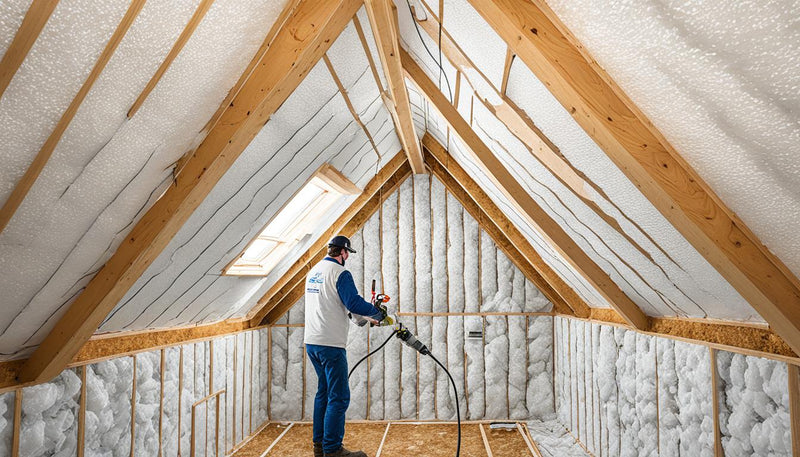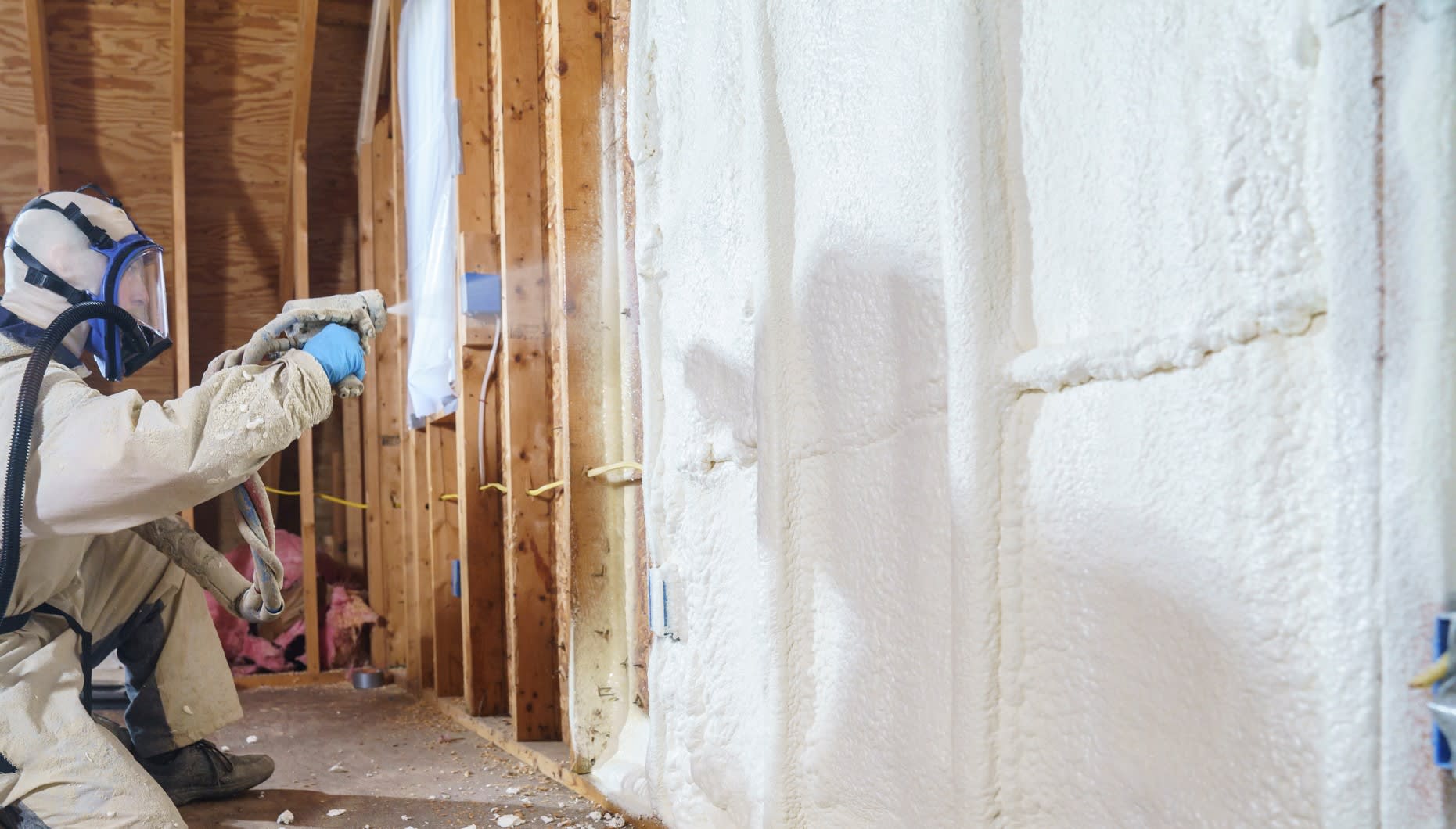The Process of Using Spray Foam: What You Need to Know
The Process of Using Spray Foam: What You Need to Know
Blog Article
Spray Foam: The Ultimate Option for Air Sealing and Insulation
Spray foam insulation has actually emerged as a leading option for reliable air securing and thermal insulation, providing an unique combination of residential or commercial properties that set it in addition to traditional methods. Its capacity to broaden and fill voids makes it especially reliable in preventing air leakage, which can dramatically influence energy performance. Nevertheless, recognizing the full extent of its benefits, setup processes, and contrasts with other insulation types is essential for making informed decisions. As we explore these elements, the effects for both brand-new constructions and retrofits become increasingly significant. What variables should affect your selection?
What Is Spray Foam?
Spray foam is a flexible insulation product that integrates the concepts of air sealing and thermal resistance to boost power efficiency in buildings. Composed largely of polyurethane or other similar compounds, spray foam is applied as a liquid that broadens upon call with surface areas, creating a solid, continuous layer of insulation. This distinct residential or commercial property enables it to load gaps, fractures, and voids that traditional insulation materials may forget, supplying an exceptional air seal.
There are 2 main types of spray foam: open-cell and closed-cell. Open-cell spray foam is lighter and much more adaptable, using exceptional sound absorption and a reduced R-value per inch - Spray Foam. In comparison, closed-cell spray foam is denser, offering a higher R-value, wetness resistance, and included architectural integrity to building elements
The application process normally involves specific tools, making certain a smooth application that follows numerous substratums, including wood, metal, and concrete. This flexibility makes spray foam appropriate for both new constructions and retrofitting existing frameworks. Its capacity to develop a closed obstacle significantly contributes to reducing energy intake and improving interior air quality, consequently making it a recommended choice amongst contractors and property owners alike.
Advantages of Spray Foam Insulation
Among the most significant benefits of spray foam insulation is its outstanding capacity to develop a continuous air barrier, which successfully reduces energy loss. Unlike standard insulation products, spray foam broadens to load voids and splits, making sure that air leak is considerably reduced. This characteristic not just enhances energy performance however also results in lower energy expenses gradually.
Additionally, spray foam insulation supplies superior thermal resistance, adding to a much more stable indoor environment. Its high R-value per inch permits efficient insulation in restricted rooms, making it ideal for attic rooms, wall surfaces, and crawl areas. In addition, the moisture-resistant buildings of spray foam help protect against mold and mildew and mildew development, promoting much healthier living conditions.
One more important advantage of spray foam insulation is its sound-dampening high qualities (Spray Foam). It properly decreases noise transmission in between spaces, creating a quieter and more comfortable home atmosphere. The resilience of spray foam likewise stands out, as it does not sag or work out in time, maintaining its performance throughout its life expectancy
Just How Spray Foam Functions
Understanding exactly how spray foam insulation works is important for appreciating its performance in air sealing and thermal resistance. Spray foam insulation consists of two key components: isocyanate and polyol resin. When these elements are blended, they undertake a chain reaction that causes the product to expand rapidly, developing a dense foam that fills voids, tooth cavities, and fractures.
As the foam expands, it abides by surface areas, creating a closed seal that substantially decreases air seepage. This characteristic makes spray foam insulation highly effective at stopping drafts and wetness infiltration, which can lead to power loss and damages gradually. Additionally, the closed-cell variation of spray foam provides superior thermal resistance because of its inflexible framework, effectively decreasing heat transfer.
The one-of-a-kind properties of spray foam allow it to adapt uneven surface areas, guaranteeing comprehensive insurance coverage and a seamless barrier. Therefore, spray foam insulation not only boosts power efficiency yet also contributes to enhanced interior air top quality by minimizing the build-up of irritants and toxins. Eventually, comprehending the auto mechanics behind spray foam highlights its function as a superior selection for insulation and air sealing in both business and residential applications.
Installment Process Overview

Before installment, the room needs to be effectively cleansed and prepped, guaranteeing that surfaces are devoid of dampness, particles, and dust. Because contaminants can compromise attachment and total efficiency, this action is essential. Once the area is prepared, the application entails blending the 2 components of the spray foam, which increases upon contact and loads voids successfully.
Educated experts ought to conduct the installment, making use of specialized tools to guarantee consistent protection and optimum density. Safety safety measures, consisting of using protective equipment and ensuring appropriate ventilation, are imperative throughout this process. After application, the foam generally treatments rapidly, creating a strong obstacle that boosts power effectiveness.
Contrasting Spray Foam to Conventional Insulation
When evaluating insulation choices, spray foam insulation stands out in comparison to conventional materials such as fiberglass and cellulose. Unlike fiberglass and cellulose, which can enable air infiltration, spray foam expands upon application, filling up crevices and gaps to produce a closed seal.
In addition, spray foam provides a higher R-value per inch than traditional insulation types, providing more effective thermal resistance in special info a thinner account. This particular is especially helpful precede with limited dental caries deepness. Spray foam is immune to moisture and mold growth, which can be a substantial issue with cellulose and fiberglass, especially in damp environments.
However, spray foam insulation normally carries a higher ahead of time cost than its see this page conventional equivalents. House owners must weigh this preliminary financial investment against lasting energy financial savings and performance advantages. Ultimately, while both insulation kinds serve their purpose, spray foam becomes a much more advanced service for modern-day insulation demands, specifically in regards to air securing and thermal performance.

Final Thought
In summary, spray foam insulation represents an extremely efficient option for accomplishing optimal air securing and thermal resistance. Its distinct residential or commercial properties, including dampness resistance and noise dampening, make it appropriate for different applications in both brand-new buildings and retrofitting jobs (Spray Foam). Although the initial prices may be higher contrasted to standard insulation products, the long-term benefits, such as considerable power savings and enhanced interior air top quality, warrant the financial investment and highlight its value in modern structure practices.
Spray foam insulation has actually emerged as a leading solution for reliable air sealing and thermal insulation, providing an unique mix of buildings that establish it apart from standard methods.Spray foam is a functional insulation product that incorporates the concepts of air sealing and thermal resistance to boost power effectiveness in buildings.When examining insulation alternatives, spray foam insulation stands out in comparison to traditional products such as fiberglass and cellulose. Ultimately, while both insulation kinds offer their purpose, spray foam arises as an extra innovative service for modern like this insulation requirements, especially in terms of air securing and thermal performance.
In summary, spray foam insulation stands for a very efficient option for accomplishing ideal air sealing and thermal resistance.
Report this page